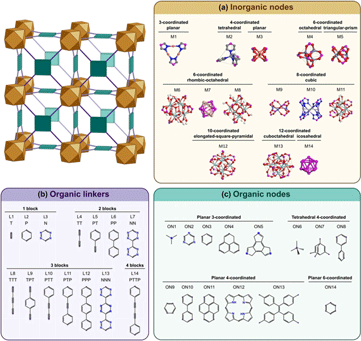Crossref Citations
This article has been cited by the following publications. This list is generated based on data provided by
Crossref.
Windischbacher, Andreas
Steiner, Luca
Haldar, Ritesh
Wöll, Christof
Zojer, Egbert
and
Kelterer, Anne-Marie
2020.
Exciton Coupling and Conformational Changes Impacting the Excited State Properties of Metal Organic Frameworks.
Molecules,
Vol. 25,
Issue. 18,
p.
4230.
Spicher, Sebastian
Bursch, Markus
and
Grimme, Stefan
2020.
Efficient Calculation of Small Molecule Binding in Metal–Organic Frameworks and Porous Organic Cages.
The Journal of Physical Chemistry C,
Vol. 124,
Issue. 50,
p.
27529.
Li, Lanqing
Gao, Wei
Lei, Min
and
Wen, Dan
2021.
Alkali‐induced Transformation of Ni‐MOF into Ni(OH)2 Nanostructured Flowers for Efficient Electrocatalytic Methanol Oxidation Reaction.
Chemistry – A European Journal,
Vol. 27,
Issue. 42,
p.
10966.
Wagner, Michal
Andrew Lin, Kun-Yi
Oh, Wen-Da
and
Lisak, Grzegorz
2021.
Metal-organic frameworks for pesticidal persistent organic pollutants detection and adsorption – A mini review.
Journal of Hazardous Materials,
Vol. 413,
Issue. ,
p.
125325.
Mialane, P.
Mellot-Draznieks, C.
Gairola, P.
Duguet, M.
Benseghir, Y.
Oms, O.
and
Dolbecq, A.
2021.
Heterogenisation of polyoxometalates and other metal-based complexes in metal–organic frameworks: from synthesis to characterisation and applications in catalysis.
Chemical Society Reviews,
Vol. 50,
Issue. 10,
p.
6152.
Stanton, Robert
Russell, Emma
Brandt, Hayden
and
Trivedi, Dhara J.
2021.
Capture of Toxic Oxoanions from Water Using Metal–Organic Frameworks.
The Journal of Physical Chemistry Letters,
Vol. 12,
Issue. 37,
p.
9175.
Taft, Carlton Anthony
Canchaya, Jose Gabriel Solano
dos Santos, Jose Divino
and
Silva, Junio Cesar Francisco
2021.
Functional Properties of Advanced Engineering Materials and Biomolecules.
p.
27.
Urrego‐Ortiz, Ricardo
Builes, Santiago
and
Calle‐Vallejo, Federico
2021.
Fast Correction of Errors in the DFT‐Calculated Energies of Gaseous Nitrogen‐Containing Species.
ChemCatChem,
Vol. 13,
Issue. 10,
p.
2508.
Polash, Shakil Ahmed
Khare, Tushar
Kumar, Vinay
and
Shukla, Ravi
2021.
Prospects of Exploring the Metal–Organic Framework for Combating Antimicrobial Resistance.
ACS Applied Bio Materials,
Vol. 4,
Issue. 12,
p.
8060.
Ghohrodi, Arsalan Rahmani
Ramezanzadeh, Mohammad
and
Ramezanzadeh, Bahram
2022.
Investigating the thermo-mechanical and UV-shielding properties of a nano-porous Zr(IV)-type metal-organic framework (MOF) incorporated epoxy composite coating.
Progress in Organic Coatings,
Vol. 164,
Issue. ,
p.
106693.
Rimsza, Jessica M.
Henkelis, Susan E.
Rohwer, Lauren E. S.
Sava Gallis, Dorina F.
and
Nenoff, Tina M.
2022.
Crystal Prediction and Design of Tunable Light Emission in BTB‐Based Metal‐Organic Frameworks.
Advanced Optical Materials,
Vol. 10,
Issue. 16,
Quainoo, Timothy
Lavan, Sydney N.
and
Liu, Zhen-Fei
2022.
Van der Waals density functional study of hydrocarbon adsorption and separation in metal–organic frameworks without open metal sites.
Journal of Materials Research,
Vol. 37,
Issue. 1,
p.
334.
Lawrence, Arputham Shophia
Sivakumar, Balasubramanian
and
Dhakshinamoorthy, Amarajothi
2022.
Detecting Lewis acid sites in metal-organic frameworks by density functional theory.
Molecular Catalysis,
Vol. 517,
Issue. ,
p.
112042.
Firooz, Sepideh Khaki
and
Armstrong, Daniel W.
2022.
Metal-organic frameworks in separations: A review.
Analytica Chimica Acta,
Vol. 1234,
Issue. ,
p.
340208.
Yang, Yuhan
Ibikunle, Ifayoyinsola A.
Sava Gallis, Dorina F.
and
Sholl, David S.
2022.
Adapting UFF4MOF for Heterometallic Rare-Earth Metal–Organic Frameworks.
ACS Applied Materials & Interfaces,
Vol. 14,
Issue. 48,
p.
54101.
Krstić, Marjan
Fink, Karin
and
Sharapa, Dmitry I.
2022.
The Adsorption of Small Molecules on the Copper Paddle-Wheel: Influence of the Multi-Reference Ground State.
Molecules,
Vol. 27,
Issue. 3,
p.
912.
Bonakala, Satyanarayana
Abutaha, Anas
Elumalai, Palani
Samara, Ayman
Mansour, Said
and
El-Mellouhi, Fedwa
2022.
Democratizing the Assessment of Thermal Robustness of Metal–Organic Frameworks.
ACS Omega,
Vol. 7,
Issue. 50,
p.
46515.
Ahmad, Awais
Tariq, Sadaf
Ahmad, Ikram
and
Luque, Rafael
2023.
Nanomaterial-Based Metal Organic Frameworks for Single Atom Catalysis.
p.
261.
Choudhuri, Indrani
Ye, Jingyun
and
Truhlar, Donald G.
2023.
Computational quantum chemistry of metal–organic frameworks.
Chemical Physics Reviews,
Vol. 4,
Issue. 3,
Han, Xue
Yang, Sihai
and
Schröder, Martin
2023.
Metal–Organic Framework Materials for Production and Distribution of Ammonia.
Journal of the American Chemical Society,
Vol. 145,
Issue. 4,
p.
1998.



